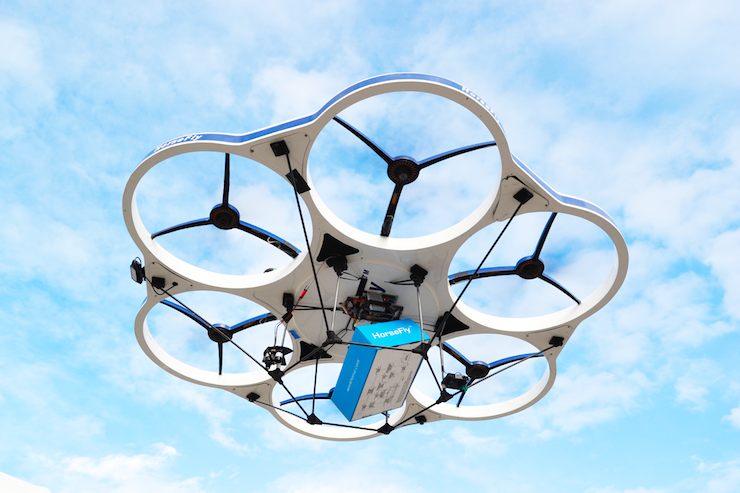Workhorse Company Looking at Drones and Delivery Trucks Working Together to Speed up Deliveries

Familiar with the saying “What happens in Vegas, stays in Vegas”? Well, not anymore since Las Vegas, NV has moved past their image of being a city of sin. Today Las Vegas is the home to some of the best entertainers on the planet, incredible shopping, family friendly attractions, and the host of countless trade expositions. One such event that has been held in Las Vegas for the last few years is the PACK EXPO. As explained on their website, “The PACK EXPO brand represents a quality trade show experience that focuses on packaging and processing innovation while bringing together a wide range of industries. PACK EXPO trade shows continue to stay on the cutting edge of industry trends and answer demand for innovations in various industries.” When the package delivery company Workhorse attended the PACK EXPO they demonstrated their latest plans for improving the package industry.
Based out of Loveland, OH Workhorse first began by looking at ways to create more reliable, eco-friendly delivery trucks. They supply delivery companies like UPS, DHL, and FedEx with electric vans that have a 100 mile range before needing a recharge. This means that deliveries are made possible with less of a carbon footprint while not compromising delivery routes and times. But as Duane Hughes, the CEO of Workhorse said, “Leading a revolution takes a new kind of power”, and they were looking for ways to power up the delivery world. At the PACK EXPO they revealed their plans to incorporate drones with their delivery trucks.
Workhorse’s idea is by no means a novel one, delivery companies across the United States are vying to be able to make drone deliveries an actuality. Amazon and Google have both been teasing customers of this possibility for some time now. Most of these companies planning to use drones to deliver goods will have drones launched from one location, like the back of a store or warehouse, and land at either a centralized drop off point or even someone’s front door. The model proposed by Workhorse is quite different. They want to launch the drones from their delivery trucks.
Their idea is to cut out some of the logistical issues of a drone launch site being too far from it’s delivery site for both battery power and line of sight. Workhorse plans to use drones for that final mile of delivery when logical. A drone will lift off from a specialized platform on the roof of the van and fly to the coordinates programed to match the package’s destination. The drone will be equipped with geofencing restrictions for safety as well as be monitored by an operator through the drone’s camera. The package is carried in a basket underneath the drone. When the drone reaches it’s destination it will glide down to the ground and release the lock on the basket, leaving the package on the ground. Then the drone flies back to the truck and docks into it’s platform so the truck can safely move on.
When delivery companies are planning their routes, the goal is to cover the least amount of miles a day while still completing all deliveries. By using drones to complete the last mile of a delivery route, companies like UPS can save huge amounts of money. Mike Dektas, a spokesperson from Workhorse, pointed out, “If drivers cut out one mile of driving a day that would add up to $54 million in fuel savings for the year.” The software on the truck analyzes the best route possible for drivers to travel with minimal mileage. The software also analyzes the packages to determine which ones would be the most logical to deliver by drone. If a package is to large, heavy, or awkward for a drone to carry, it obviously needs to be hand delivered.
The system Workhorse demonstrated at the PACK EXPO is called HorseFly, and since that demonstration they have ventured out of Vegas and begun deliveries in Ohio and Florida. They have been able to do this after being granted permission by the FAA for virtual beyond line of sight flights. The FAA is still reluctant on granting true BVLOS (beyond visual line of sight) operations, but Workhorse’s system uses virtual BVLOS by using the drones camera for visual input rather than autonomous flight.
HorseFly can carry a package up to 10lbs and fly for 30 minutes before needing to be recharged. As Workhorse’s Steve Burns said, “We feel this is a game-changing moment to innovate the way packages are delivered for many years to come.” A drone and delivery truck integrated system can revolutionize the way delivery companies operate and save money. Mark Wallace, former VP of global engineering and sustainability at UPS explained the benefits perfectly when he said, “This test is different than anything we’ve done with drones so far. It has implications for future deliveries, especially in rural locations where our package cars often have to travel miles to make a single delivery. Imagine a triangular delivery route where the stops are miles apart by road. Sending a drone from a package car to make just one of those deliveries can reduce costly miles driven. This is a big step toward bolstering efficiency in our network and reducing our emissions at the same time.”
|